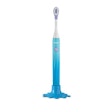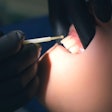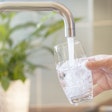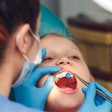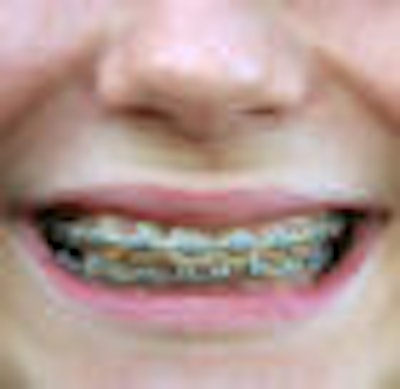
An orthodontic device that uses vibration therapy to speed tooth movement in conjunction with conventional orthodontic treatment is undergoing clinical testing at the University of Texas Health Science Center at San Antonio.
— Mike Lowe, president of OrthoAccel
The AcceleDent, which is being commercialized by OrthoAccel, a Houston-based start-up, uses vibrational force to increase the rate of alveolar bone turnover, according to the company. The core technology was invented by Jeremy Mao, D.D.S., M.S.D., Ph.D., an orthodontist and bioengineer who pioneered the use of vibratory force in the craniofacial region and has published extensively on this topic.
For example, Kopher and Mao assessed cyclic forces of 5 newtons (N) peak magnitude at 1 Hz in rabbits (Journal of Bone and Mineral Research, March 2003, Vol. 18:3, pp. 521-528), while Peptan and Mao assessed cyclic forces of 1 N at 8 Hz in rabbits (Bone, February 2008, Vol. 42:2, pp. 432-438), and Vij and Mao assessed cyclic forces of 300 mN at 4 Hz in rats (Bone, May 2006, Vol. 38:5, pp. 722-730). The aggregate data from these three studies indicated that cyclic forces between 1 Hz and 8 Hz, with forces ranging from 0.3 N to 5 N, increase bone remodeling. Rates depended on different methodologies, but increases of 2.5x with vibration were common.
Through these and related studies, Dr. Mao, who is currently director of the Tissue Engineering and Regenerative Medicine Laboratory at Columbia University and chairman of OrthoAccel's Scientific Advisory Board, determined that bone remodeling can be significantly accelerated by applying pulsating force in various combinations of frequency and magnitude.
"Dr. Mao commissioned a series of animal experiments and found that applying vibrational force above the neck worked remarkably well," said Mike Lowe, president of OrthoAccel and a former executive with Philips Sonicare. "When they compared the histology of treatment with the control group, they found that the tooth movement was twice as fast when vibrational force was used."
Initial clinical study
OrthoAccel licensed Dr. Mao's discoveries and developed the AcceleDent. The product features a mouthpiece (similar to a sports mouthpiece) that is connected to an external activator that provides the vibration. The activator includes a battery, motor, rotating weights, and a microprocessor for storing usage data.
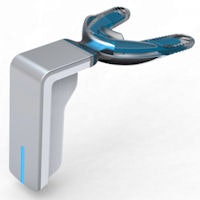 |
| The AcceleDent vibrational therapy device. Image courtesy of University of Texas Health Science Center. |
The patient uses the device once daily for 20 minutes or twice a day for 10 minutes each. The applied force is 20 grams at a frequency of 30 Hz. A Sonicare toothbrush, by comparison, operates at about 260 Hz, Lowe noted.
In a six-month pilot study conducted at University of Texas Health Science Center at Houston in 2008 (results unpublished), 17 patients (average age, 21.5 years) with class I malocclusion and at least 6 mm of lower anterior crowding were given the AcceleDent and instructed to use it for 20 minutes daily during orthodontic treatment. Compliance varied, with patients reporting they used the AcceleDent about 80% of the time, while the device documented a 67% usage rate. No adverse events were reported, and most patients said they used the device while watching television, listening to music, or playing video games.
"The compliance data was very encouraging," Lowe said. "What we learned was that patients will pick an activity that they seem to be engaged in every day and tie the use of the AcceleDent to that behavior, such as driving to work, doing the dishes, etc. Some even wanted to use it in the shower, so we had the engineers make the device more waterproof."
Using the Galileos cone-beam CT system (Sirona Dental Systems), the Houston researchers -- under the direction of Jeryl English, D.D.S., M.S., program director for the department of orthodontics -- measured tooth roots and estimated resulting root resorption to determine if any root resorption greater than 0.5 mm occurred or if there were alterations in root lengths. They found that the differences in mean root lengths, with measurements made to the mesial buccal roots of all teeth except the second and third molars, ranged from -0.127 mm to -0.416 mm in both arches. These differences were not statistically significant, and the researchers noted no significant differences between anterior and posterior teeth.
However, the overall tooth movement rate during the study was 0.526 mm per week, which is about 30% to 50% faster than published historical rates, according to OrthoAccel.
Phase II trial
The larger randomized controlled study now under way at the University of Texas Health Science Center at San Antonio involves 34 patients, ages 12 to 40, who received standard orthodontic treatment and were fitted for braces at the center's orthodontic clinic. They are being provided with an AcceleDent to use at home and instructed to use it for 20 minutes a day.
"We believe the application of cyclic loading (vibration) will not only increase the rate of tooth movement but will create a solid foundation of bone and adjacent tissues in the mouth and result in more stable outcomes for orthodontic treatment," said Dubravko Pavlin, D.M.D., M.S.D., Ph.D., an associate professor in the department of orthodontics. "This approach would allow us to treat patients using either standard metal braces or the plastic removable braces, and to treat more complicated cases with more stable outcomes."
OrthoAccel hopes the results from this trial will pave the way for the company to apply for 510(k) marketing clearance with the U.S. FDA next year. AcceleDent is already cleared for use in Europe, and the company officially launched it at the British Orthodontic Conference in Edinburgh, U.K., last week.
"This is a new product, a new science," Lowe said. "We are regulating the bone biology. This is not a toy."
Copyright © 2009 DrBicuspid.com













